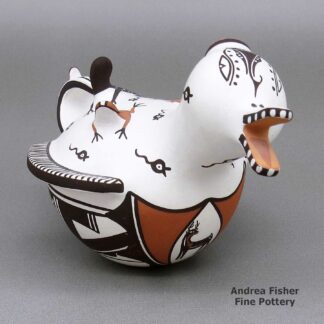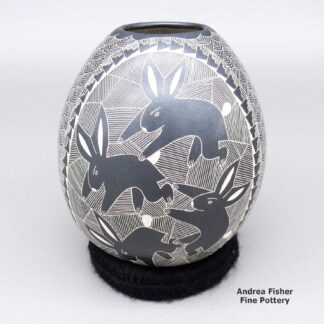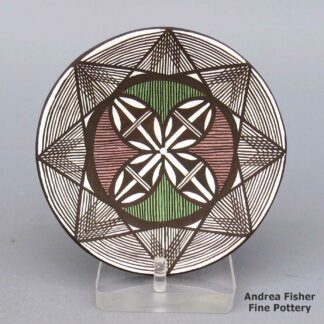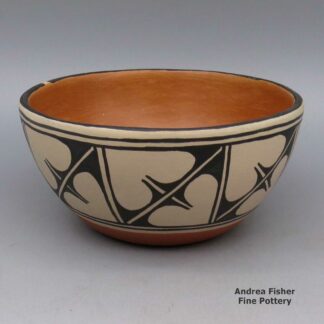Geometric design
About Geometric Designs
"Geometric design" is a catch-all term. Yes, we use it to denote some kind of geometric design but that can include everything from symbols, icons and designs from ancient rock art to lace and calico patterns imported by early European pioneers to geometric patterns from digital computer art. In some pueblos, the symbols and patterns denoting mountains, forest, wildlife, birds and other elements sometimes look more like computer art that has little-to-no resemblance to what we have been told they symbolize. Some are built-up layers of patterns, too, each with its own meaning.
"Checkerboard" is a geometric design but a simple black-and-white checkerboard can be interpreted as clouds or stars in the sky, a stormy night, falling rain or snow, corn in the field, kernels of corn on the cob and a host of other things. It all depends on the context it is used in, and it can have several meanings in that context at the same time. Depending on how the colored squares are filled in, various basket weave patterns can easily be made, too.
"Cuadrillos" is a term from Mata Ortiz. It denotes a checkerboard-like design using tiny squares filled in with paints to construct larger patterns.
"Kiva step" is a stepped geometric design pattern denoting a path into the spiritual dimension of the kiva. "Spiral mesa" is a similar pattern, although easily interpreted with other meanings, too. The Dineh have a similar "cloud terrace" pattern.
That said, "geometric designs" proliferated on Puebloan pottery after the Spanish, Mexican and American settlers arrived with their European-made (or influenced) fabrics and ceramics. The newcomers' dinner dishes and printed fabrics contributed much material to the pueblo potters design palette, so much and for so long that many of those imported designs and patterns are considered "traditional" now.
Showing 1–12 of 331 results
-

Agnes Peynetsa, ppzu3c030, Jar with deer-with-heart-line and geometric design
$625.00 Add to cart -

Agnes Peynetsa, zzzu3b515, Duck pot with a deer with heart line design
$395.00 Add to cart -

Alex Ortega, zzcg2f357m14, Black jar with sgraffito rabbit and geometric design
$150.00 Add to cart -

Alex Ortega, zzcg2f357m2, Black jar with sgraffito rabbit, lizard and geometric design
$150.00 Add to cart -

Alex Ortega, zzcg2f357m5, Black jar with sgraffito rabbit and geometric design
$150.00 Add to cart -

Alex Ortega, zzcg3b107m4, Jar with a geometric design
$185.00 Add to cart -

Alex Ortega, zzcg3b107m7, Jar with a geometric design
$185.00 Add to cart -

Alisha Sanchez, zzac2m080m1, Polychrome plate with geometric design
$175.00 Add to cart -

Alvin Curran, zzsj2m512, Polychrome bowl with feather and geometric design
$2,200.00 Add to cart -

Alvina Garcia, btsd2l257: Polychrome bowl with geometric design
$250.00 Add to cart -

Amanda Lucario, zzac3b132m1, Seed pot with a geometric design
$195.00 Add to cart -

Amanda Lucario, zzac3b132m2, Seed pot with a geometric design
$195.00 Add to cart
Showing 1–12 of 331 results